Guitar pedals are essential tools for musicians, enabling players to shape their sound and enhance their creativity.
This beginner’s guide examines the various types of guitar pedals, including distortion, delay, modulation, and more. It provides practical tips for setting up a pedalboard and utilizing multiple effects simultaneously, while also highlighting common mistakes to avoid.
Additionally, the guide offers insights on selecting the appropriate pedals to suit individual playing styles.
Whether one is just beginning their musical journey or seeking to refine their existing setup, this guide serves as a comprehensive resource.
What are Guitar Pedals?
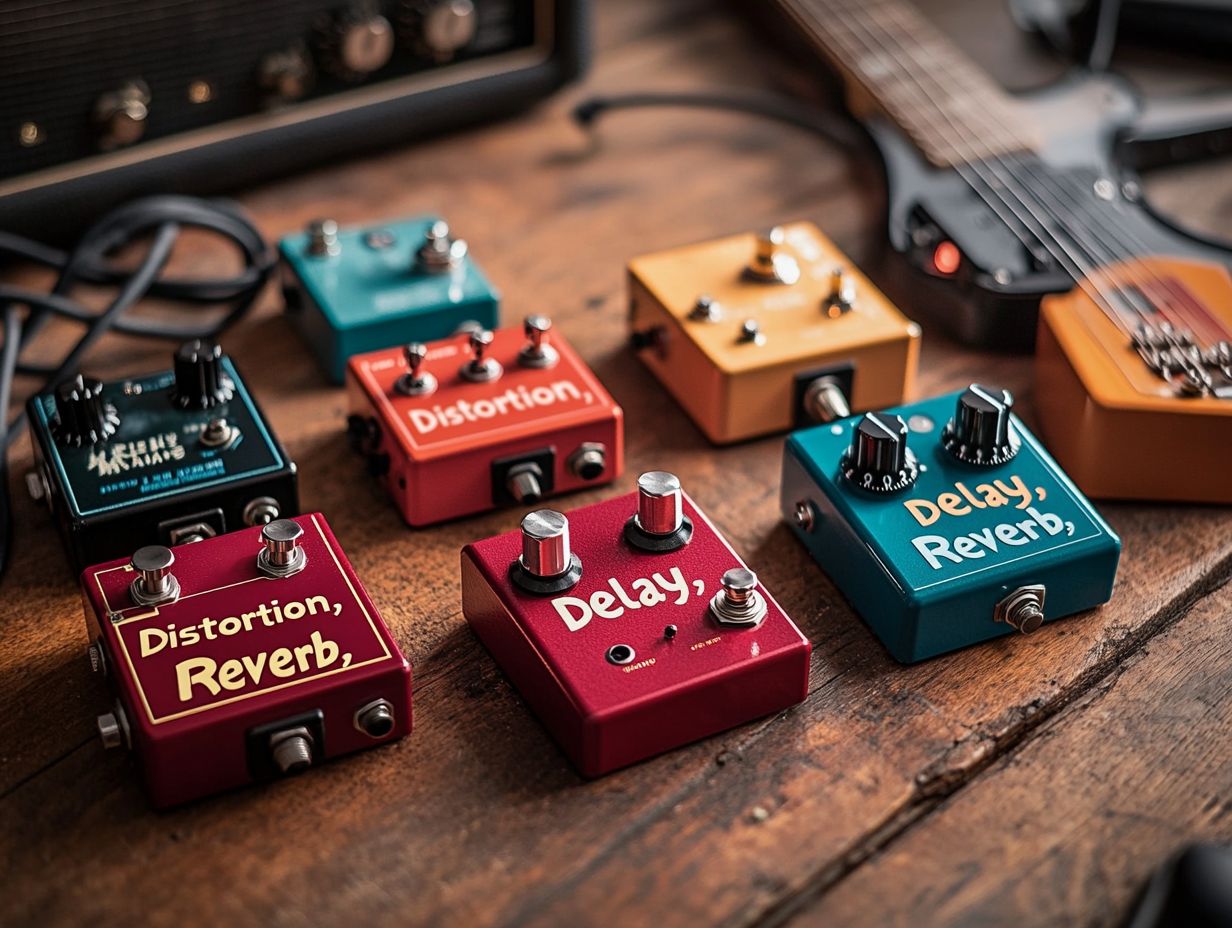
Guitar pedals, commonly referred to as effects pedals or stompboxes, are critical tools for guitarists aiming to enhance their tonal quality and sound effects. They constitute fundamental components within a guitarist’s setup, facilitating a range of sonic experimentation through various effects, including overdrive, distortion, delay, reverb, and modulation.
These devices may be either analog or digital, and they play a crucial role in shaping the overall musical expression and audio quality during both live performances and studio recordings.
The functionalities of guitar pedals extend well beyond simple effects; they provide musicians with the capability to manipulate the sound of their instruments in numerous ways, adding depth and character that can significantly elevate a performance. By strategically positioning these pedals within a signal chain, players can create a distinctive sonic landscape that reflects their unique style.
For beginners, the user-friendly nature of these devices offers an intuitive introduction to sound manipulation, while experienced guitarists value the extensive range of options available for fine-tuning their tone.
Furthermore, the compact and portable design of guitar pedals makes them ideal for travel, allowing them to fit conveniently into a gig bag and enabling musicians to transport their signature sounds effortlessly.
Types of Guitar Pedals
Guitar pedals are available in a diverse array of types, each engineered to produce distinct sounds and effects that cater to various musical genres and individual preferences. It is essential for musicians to comprehend the different types of guitar pedals in order to effectively integrate them into their setups.
Common categories encompass:
- Distortion and overdrive pedals, which add grit to the sound;
- Delay and reverb pedals, which create spacious effects;
- Modulation pedals, such as chorus and flanger, that enrich the sonic palette.
Furthermore, specialized pedals like wah, fuzz, and compressor serve to enhance tonal versatility.
Distortion and Overdrive Pedals
Distortion and overdrive pedals are essential components in shaping a guitarist’s tone, as they add grit and sustain to the sound while enhancing musical expression. Distortion pedals produce a heavily processed sound that is particularly suited for genres such as rock and metal, whereas overdrive pedals offer a warmer, more natural amplification effect, making them ideal for blues and classic rock.
Both types of pedals play a significant role in the signal chain, enabling musicians to explore sonic creativity and achieve dynamic feedback during live performances or studio recordings.
These devices not only differ in their degrees of gain and clipping but also influence the approach guitarists take in their playing styles. Distortion pedals typically deliver a sharp attack and aggressive sustain, making them well-suited for high-energy riffs and solos. In contrast, overdrive pedals enhance the natural characteristics of the amplifier, promoting dynamic playing with smooth transitions.
When integrating both types of pedals into a pedalboard setup, musicians should carefully consider their order. Placing overdrive before distortion can yield a fuller sound while maintaining clarity.
Experienced players often utilize both pedals in tandem, switching between them to craft distinct textures that elevate their musical expression.
Delay and Reverb Pedals
Delay and reverb pedals are integral components for achieving depth and ambiance in guitar performance, significantly enriching the overall sonic experience. Delay pedals replicate the input signal at predetermined intervals, thereby adding a sense of spatiality and rhythm. In contrast, reverb pedals emulate the natural reflections of sound within an environment, offering a rich backdrop for musical expression.
When used in conjunction, these effects provide musicians with the capability to layer sounds and create complex soundscapes, making them highly valued among artists seeking to elevate their audio experience during both live performances and recordings.
For example, in the realms of rock and pop music, a subtle delay can introduce a rhythmic pulse that enhances rhythm guitar, while a lush reverb can elevate a vocal line into a soaring and atmospheric melody. In genres such as ambient or shoegaze, the optimal use of both effects enables performers to construct expansive and immersive environments that engage listeners deeply within the sound.
To effectively utilize these effects, musicians frequently experiment with the timing and feedback settings on delay pedals to ensure alignment with the tempo of their compositions. Additionally, adjusting reverb levels allows them to identify the ideal balance that contributes depth without compromising the clarity of the mix.
With dedicated practice, these tools can be mastered to enhance tonal quality and foster creativity in performances.
Modulation Pedals
Modulation pedals provide a versatile array of effects capable of transforming a guitar’s sound, thereby enhancing its richness and movement. Among the most common modulation effects are chorus, which enriches the sound by layering multiple pitches, and flanger, which produces a sweeping effect reminiscent of a jet aircraft.
These pedals play a vital role in fostering creativity in sound and are frequently employed to enhance dynamics and musical expression during both live performances and studio recordings.
The introduction of a chorus pedal enables musicians to achieve a lush, shimmering effect that often mimics the richness of a full ensemble, making it particularly effective in genres such as pop and rock. Conversely, flanger pedals contribute a more pronounced, swirling texture that can elevate a solo or bridge section, introducing an element of surprise and excitement.
Both types of modulation effects integrate seamlessly with other pedals on a pedalboard, such as overdrive or delay, thereby creating a captivating sonic landscape that engages listeners and maintains their attention.
Wah and Volume Pedals
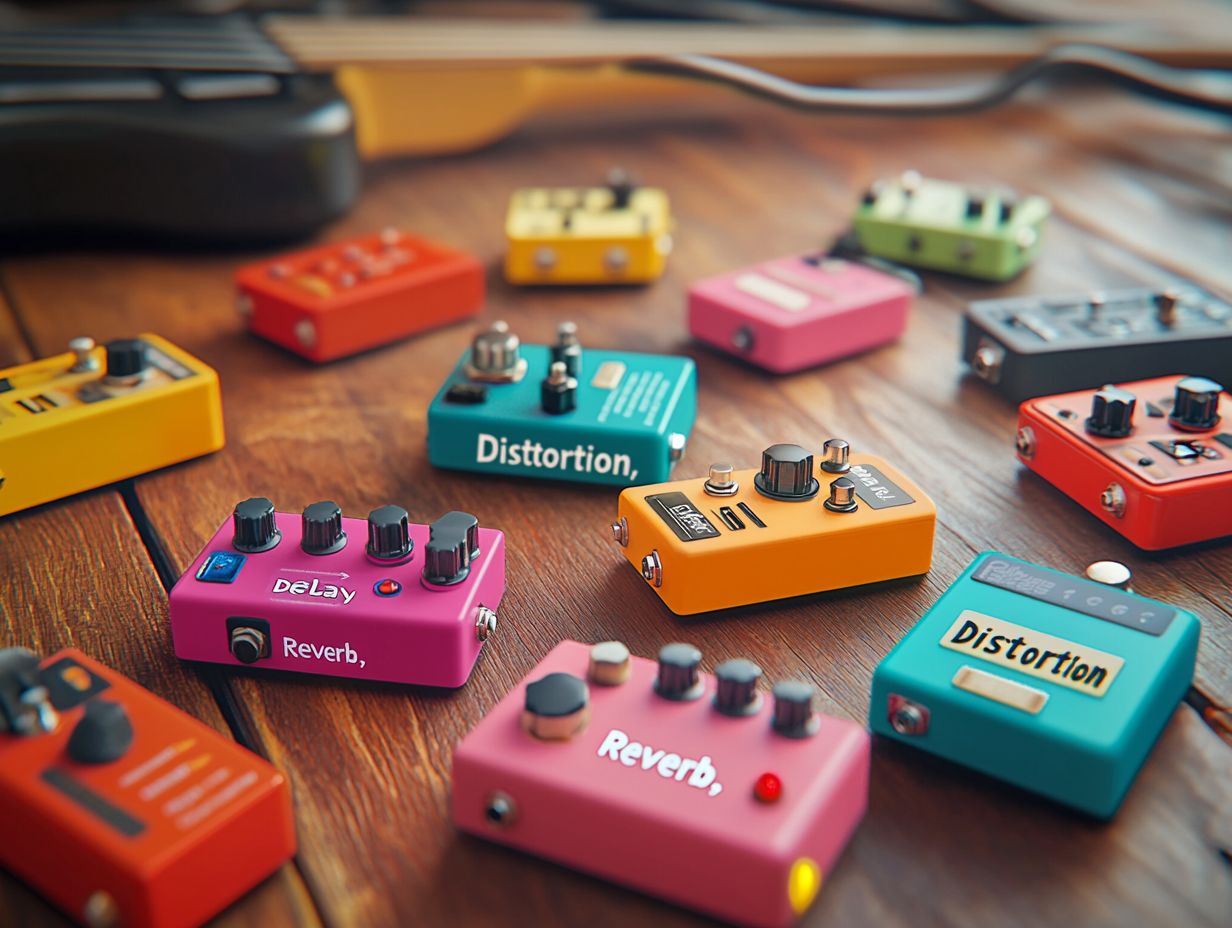
Wah and volume pedals are critical tools for achieving nuanced tonal control and expression in guitar playing. The wah pedal enables musicians to dynamically manipulate tone and frequencies, producing a vocal-like sound effect that has become iconic across various musical genres.
In contrast, the volume pedal allows for precise control over the output level, facilitating smooth transitions and swells that enhance musical expression and sound dynamics, both in live performances and studio recordings.
Incorporating these pedals into a guitarist’s setup not only improves performance but also encourages experimentation with sound. When utilized judiciously, the wah pedal can add emotional depth to solos, while the volume pedal plays a critical role in creating crescendos and fades that engage audiences.
To effectively integrate these tools into a pedalboard, musicians should prioritize their placement; wah pedals typically perform best when positioned early in the signal chain, whereas volume pedals are more effective at the end to preserve signal integrity.
Experimenting with different configurations can result in a customized setup that elevates the overall tonal palette and dynamic control, specifically tailored to the artist’s unique sound.
How to Use Guitar Pedals
Effectively utilizing guitar pedals necessitates a comprehensive understanding of their setup and integration within the signal chain. A well-organized pedalboard not only enhances the user experience but also guarantees optimal sound quality and signal integrity during live performances and studio recordings.
By familiarizing themselves with best practices for connecting pedals and comprehending their interactions, musicians can fully leverage the capabilities of their guitar effects, ultimately achieving a more refined and polished sound.
Setting Up Your Pedalboard
Setting up a pedalboard is a fundamental step in establishing an efficient and effective guitar effects configuration, requiring careful attention to wiring and power supply considerations. A well-organized pedalboard not only streamlines performance but also enhances signal processing, ensuring that each pedal operates optimally. By strategically arranging pedals according to their functions and maintaining proper signal integrity, musicians can create versatile setups that accommodate various musical genres and styles.
To initiate the setup process, it is essential to design a clean and orderly layout that allows for easy access to each effect. Position the most frequently used pedals at the front to facilitate quick adjustments during live performances.
Subsequently, ensure that the power supply aligns with the voltage and current requirements of each pedal, utilizing isolated outputs when necessary to minimize unwanted noise and interference.
When connecting pedals, employ high-quality cables and keep cable runs as short as possible to preserve signal clarity. Additionally, it is prudent to avoid common errors such as piggybacking power supplies or neglecting proper labeling, as these oversights can impede performance and result in frustrating troubleshooting during a set.
Using Multiple Pedals Together
Utilizing multiple pedals simultaneously can facilitate innovative sound design and the creation of unique tonal palettes; however, it necessitates a comprehensive understanding of pedal stacking and their interactions.
By effectively combining various types of effects, musicians can achieve an extensive range of sounds that enhance their musical expression and versatility. Thoughtful consideration of the order in which the pedals are arranged in the signal chain can significantly influence the overall sound quality and dynamics during both live performances and studio recordings.
For example, positioning a distortion pedal prior to a time-based effect, such as reverb, can result in a rich, atmospheric sound that is particularly well-suited for ambient or shoegaze music. Conversely, stacking overdrive pedals with a fuzz pedal can produce a saturated tone that is ideal for rock and metal genres.
Additionally, musicians should explore modulation effects, including chorus and flanger, to introduce depth and movement to their tones. While the range of possibilities is indeed enticing, challenges may arise, such as signal loss or unwanted feedback. Therefore, it is essential to understand the characteristics of each pedal and how they interact to achieve optimal results.
Common Mistakes to Avoid
As musicians begin their journey with guitar pedals, certain common mistakes can impede their ability to attain the desired sound quality.
It is essential to understand these beginner errors, particularly concerning effective usage and the arrangement of the signal chain, to maximize the potential of each pedal.
By recognizing frequent pitfalls such as misconfiguration or excessive use of effects, guitarists can enhance their performance, streamline troubleshooting processes, and elevate their overall musical expression.
Overusing Effects
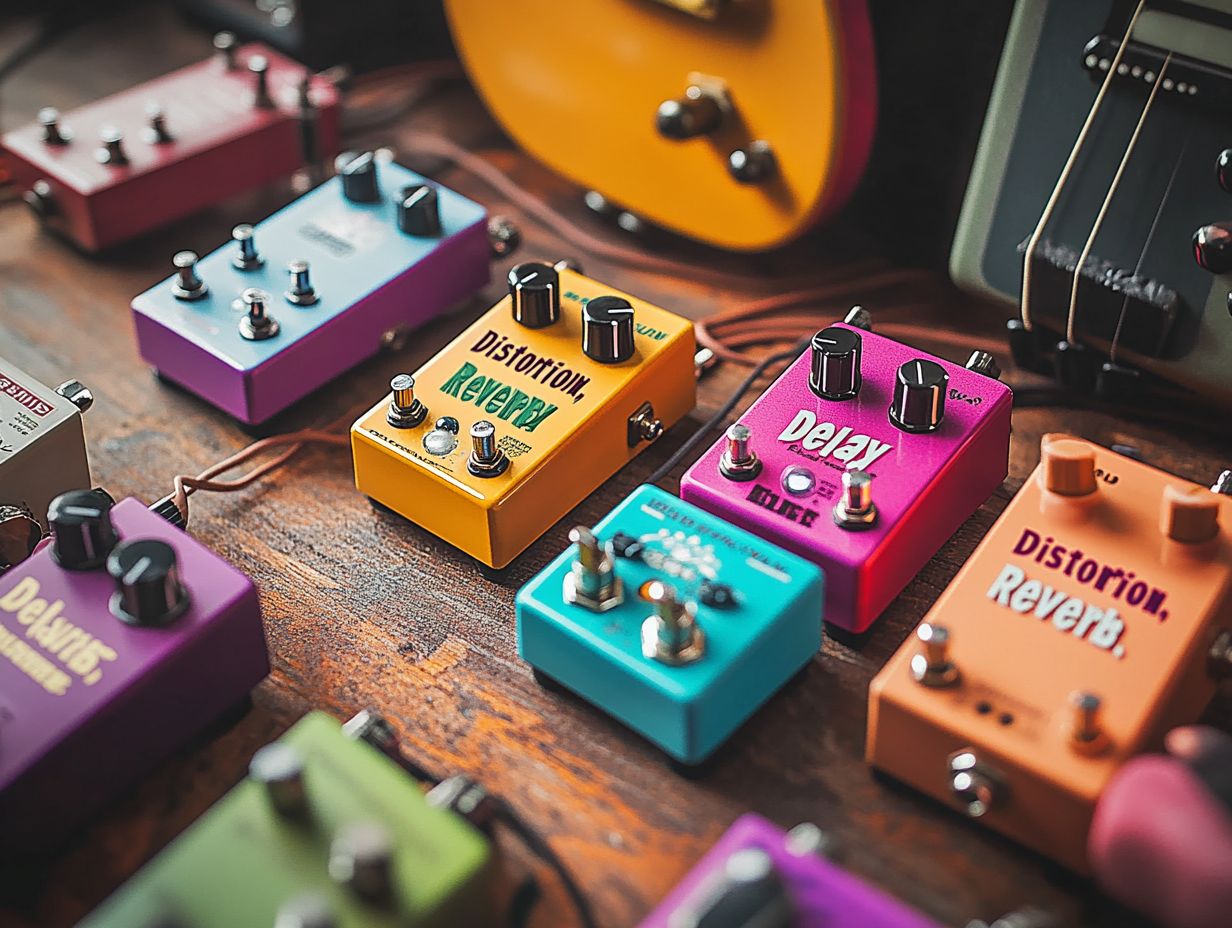
One of the most common mistakes made by guitarists is the excessive use of effects, which can result in a muddled sound and compromised sound quality. While effects pedals are intended to enhance musical expression and creativity, an overreliance on multiple effects simultaneously can obscure the fundamental tone of the guitar, particularly in live performance settings. It is crucial to achieve a balance between utilizing effects and maintaining clarity to ensure a compelling performance.
When guitarists layer an excessive number of effects—such as distortion, delay, and modulation—it can create a convoluted sonic landscape that diminishes the distinct character of each note. For example, a well-executed solo may become indistinguishable amid a wash of reverb and chorus, thereby reducing the emotional impact of the performance.
A prudent approach is to experiment with various combinations while remaining conscious of the overall sound. By simplifying the setup to one or two essential effects, guitarists can allow the natural tone of the instrument to resonate, fostering a deeper connection with the audience while still showcasing the artist’s creativity.
Not Understanding Signal Chain
A thorough understanding of the signal chain is essential for a guitarist to achieve optimal sound quality and effectively utilize their pedals. The arrangement of pedals within the signal chain determines their interaction, thereby influencing tonal characteristics and overall audio output.
Proper wiring and organization can enhance performance, while neglecting these details may result in unwanted feedback or a loss of sound clarity.
This knowledge is vital for tailoring one’s sound to accommodate various musical styles and performance environments. Organizing pedals according to their function—such as placing overdrives before delays—ensures the integrity of the signal, allowing each effect to contribute positively to the desired tone rather than detracting from it.
Furthermore, maintaining short cable lengths and employing high-quality connectors can significantly reduce noise and signal degradation. Regularly reviewing and adjusting the pedal configuration in accordance with specific performance needs can lead to substantial improvements in overall sound quality, give the power toing musicians to fully realize their creative potential.
Tips for Choosing and Buying Guitar Pedals
Selecting the appropriate guitar pedals can significantly impact one’s sound and musical expression. Therefore, it is essential to consider factors such as affordability, versatility, and compatibility with existing equipment.
Given the extensive range of options available in the pedal market, understanding the distinctions among various brands and models is crucial for making an informed decision that aligns with both budgetary constraints and sonic requirements.
By prioritizing individual playing styles and sound preferences, musicians can effectively identify the pedals that will enhance their overall setup.
Factors to Consider
When selecting guitar pedals, several critical factors must be considered to ensure compatibility and enhance tone shaping. These factors include the types of effects desired, the quality of sound manipulation, and how each pedal integrates into the overall music gear setup, including the signal chain.
Additionally, it is important to evaluate the durability and maintenance requirements of the pedals, as these aspects can significantly impact long-term satisfaction and performance.
Exploring various effects such as distortion, delay, and modulation can demonstrate how they complement different genres, enabling musicians to tailor their sound and more effectively express their artistic vision.
Understanding the interaction of pedals with the amplifier and guitar is essential, as any mismatch may result in undesirable outcomes. Selecting the appropriate power supply and ensuring that the pedals do not introduce noise can further enhance performance.
Ultimately, the objective is to create a cohesive sound that aligns with one’s style, making thoughtful pedal selection an integral aspect of any guitarist’s journey.
Recommended Brands and Models
The market offers a wide array of guitar pedals from numerous brands and models, each presenting distinct features and sound qualities tailored to different playing styles. Renowned brands such as Boss, MXR, and Electro-Harmonix provide a diverse selection that ranges from affordable options to high-end boutique pedals, catering to both novice and experienced musicians.
Familiarity with the strengths and weaknesses of various models enables individuals to make informed decisions aligned with their specific requirements.
For example, the Boss DS-1 Distortion pedal is a time-honored option that produces a warm, gritty tone, making it particularly suitable for rock and blues genres, thereby establishing itself as a fundamental choice for any guitarist. Conversely, MXR’s Phase 90 delivers a rich, swirling modulation that enhances clean tones and solos, effectively complementing funk or psychedelic styles. On the premium end, Electro-Harmonix’s Big Muff Pi is highly regarded for its robust fuzz sound, which is especially favored by metal and stoner rock musicians.
These pedals are available within various price ranges, ensuring that every guitarist, regardless of their level of experience, can discover the ideal addition to their pedalboard.
Frequently Asked Questions
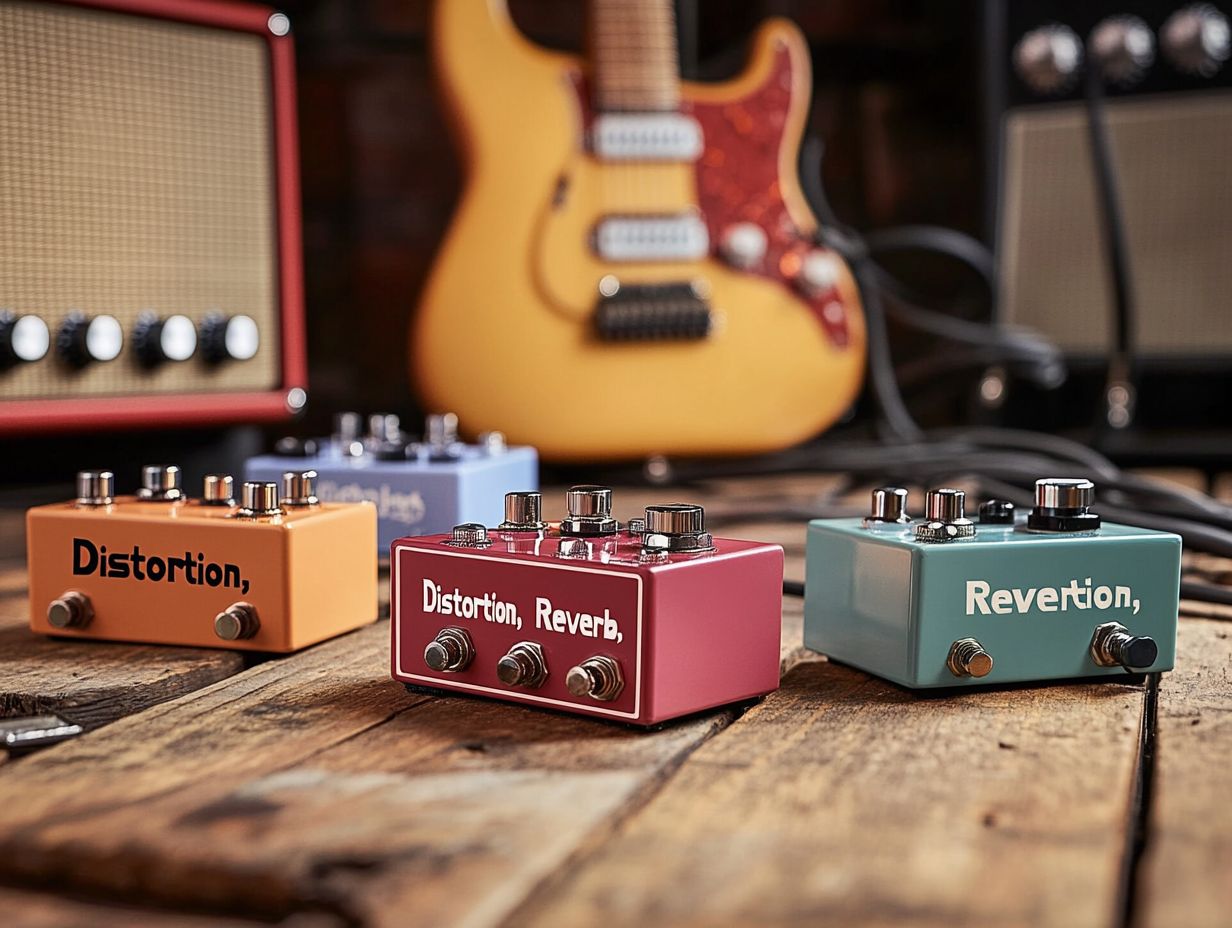
What are guitar pedals and why do I need them?
Guitar pedals are small effects units that are used to alter the sound of an electric guitar. They can add different types of effects, such as distortion, delay, and reverb, to your guitar’s sound. They are popular among guitarists because they allow for a wide range of sound possibilities and can enhance the overall sound of your playing.
What are the different types of guitar pedals?
There are several types of guitar pedals, including distortion, overdrive, delay, reverb, chorus, and wah. Each type of pedal has a specific effect on the sound of your guitar, so it’s important to understand the differences between them before choosing which ones to add to your pedalboard.
How do I set up my guitar pedals?
To set up your guitar pedals, you will need a pedalboard, a power supply, and instrument cables. First, place your pedals on the pedalboard in the order you want them to be in your signal chain. Then, use the instrument cables to connect the pedals to each other and to your amp. Finally, use the power supply to power all of your pedals.
Can I use multiple pedals at once?
Yes, you can use multiple pedals at once to create unique and layered effects. This is the beauty of guitar pedals – they allow you to experiment and create your own sound. Just remember to keep your signal chain in mind and place your pedals accordingly to avoid any unwanted noise or tone loss.
How do I know which guitar pedals to buy?
The best way to choose guitar pedals is to do research and try them out for yourself. Read reviews, watch demos, and visit a music store to test them out. It’s also important to consider your budget and the type of music you play when selecting pedals. Don’t be afraid to mix and match different pedals to create your own unique setup.
Do I need expensive pedals to get a good sound?
No, you don’t need expensive pedals to get a good sound. While there are high-quality pedals that can be quite pricey, there are also budget-friendly options that can still deliver great sound. It’s all about finding the right combination of pedals and settings for your playing style and preferences. Don’t be afraid to experiment with different pedals to find your perfect sound.

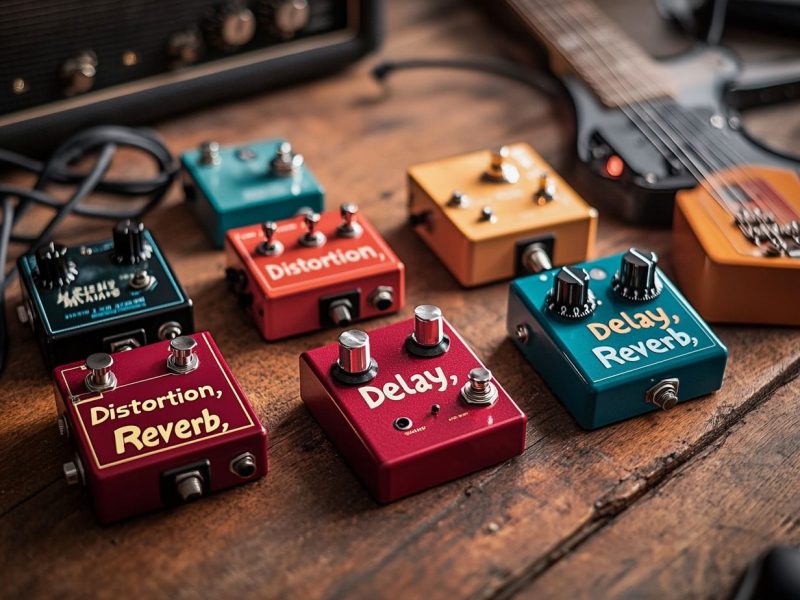
 Discover the Best Music Gear for Unforgettable Live Performances
Discover the Best Music Gear for Unforgettable Live Performances